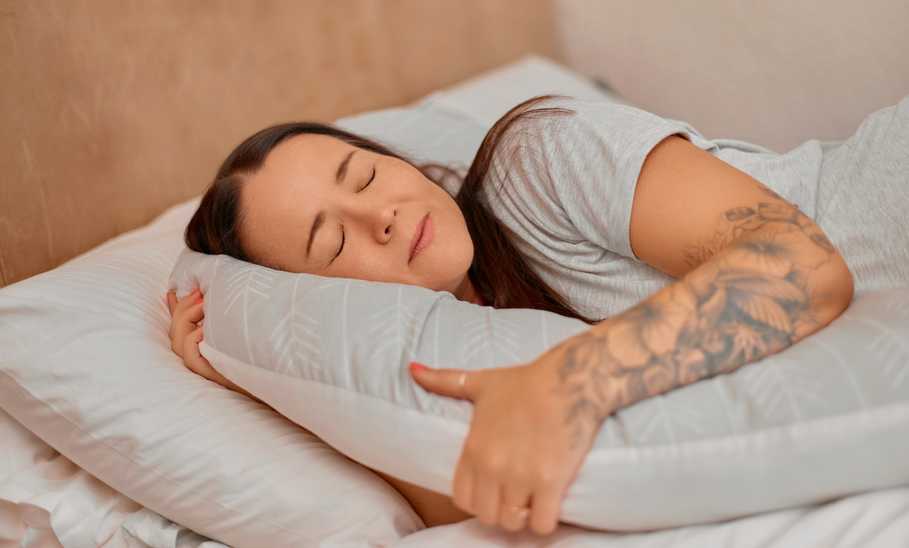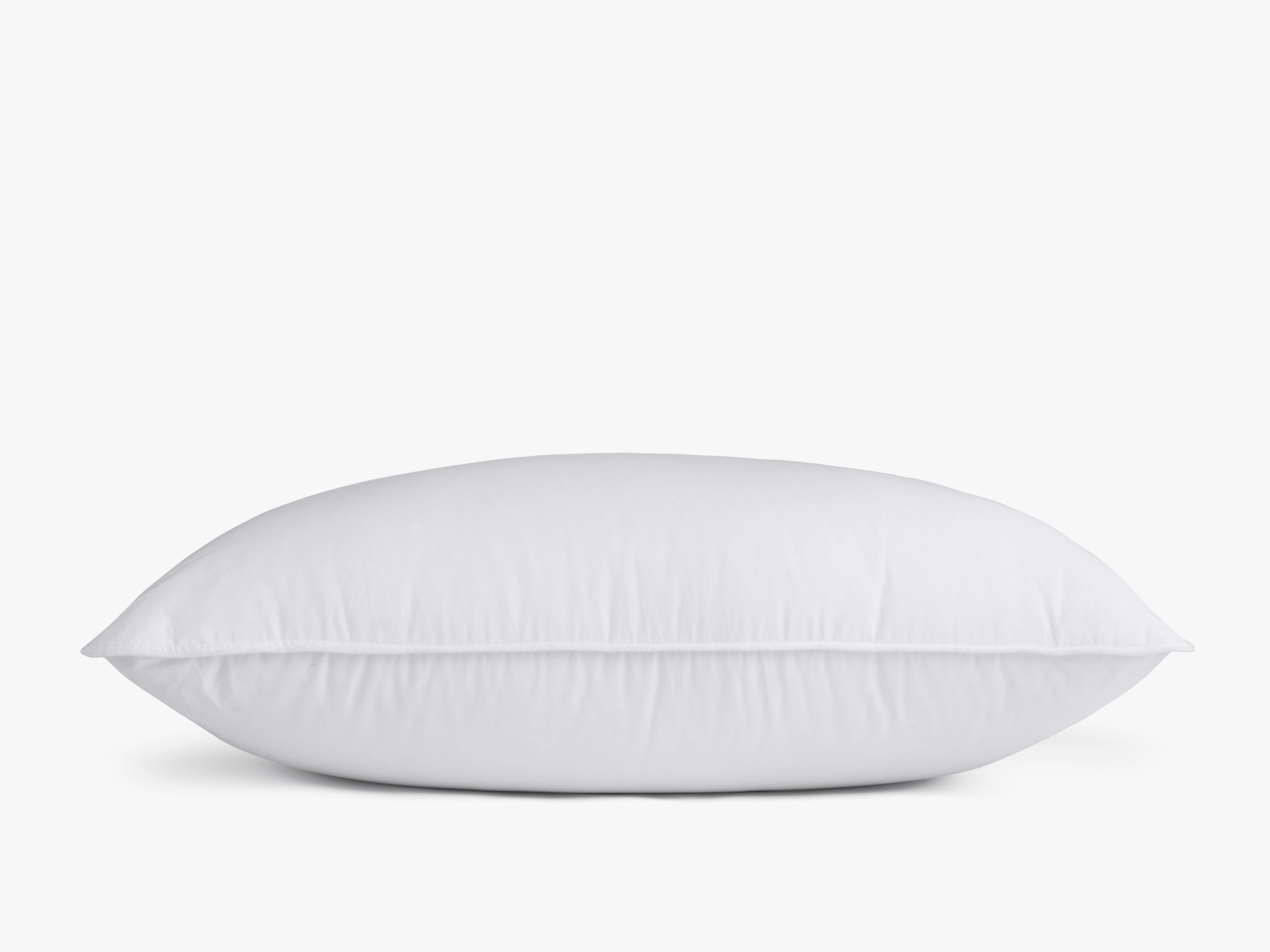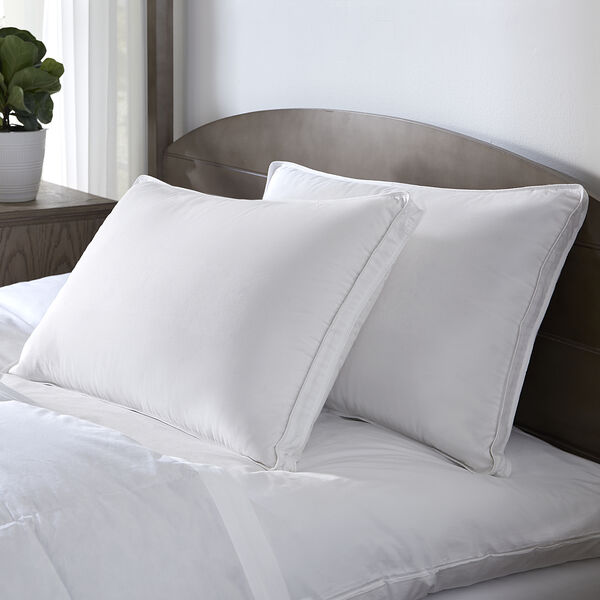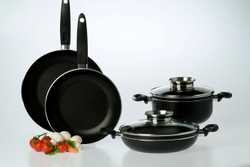- Fill material: White down
- Outer cover material: Cotton sateen
- Firmness level: Soft/medium, Medium/firm
- Available sizes: Standard, King
- Certification: RDS certified
- Price: $79.90
Best Down Pillows: 8 Comfortable Options From Firm to Soft

Our evaluations and opinions are not influenced by our advertising relationships, but we may earn a commission from our partners’ links. This content is created by TIME Stamped, under TIME’s direction and produced in accordance with TIME’s editorial guidelines and overseen by TIME’s editorial staff. Learn more about it.
There is something so cozy about snoozing with a down pillow, especially as the days get shorter and the nights longer and colder. And if you are like me and love a fluffy versus flat place to lay your head, down pillows are a wonderful option. If you enjoy the feel of down but your allergies prevent you from laying on top of feathers, there are alternatives for you as well. This fall, I tried a few down pillows to discover what makes them so popular.
Down pillows are an age-old popular filling choice but may vary slightly by brand. A hybrid of down and feathers is also available. Picking the best pillow depends on your personal comfort and sleeping habits, just like when you select a mattress or other bedding like bed sheets and comforters. "Certain pillows work best for certain sleep styles because your sleeping position affects spinal alignment," shares Byron Golub, Vice President of Product and Merchandising at Saatva. He adds that down pillows are often a good choice for side, back and stomach sleepers.
Quince makes affordable down pillows. My whole family tried these feather pillows (and may have fought over them), and everyone from stomach to side sleepers found them 100 percent comfortable. The plush factor (650 fill) is there, but the loft still allows you to have a good night’s rest without too much elevation. We loved snuggling under the bed covers with these extremely soft pillows.
These inexpensive, comfortable down pillows provide support when you sleep.

Parachute sells down pillows in a range of firmness, all made from thick and fluffy clusters, offering support to combination sleepers who favor their back and sides (like me). I tried the “medium” density, and the loft is supportive yet not too firm. If you prefer a higher density, Parachute also makes and sells down pillows specifically designed for side sleepers. While some reviews stated this pillow needed fluffing, I felt that it actually didn’t flatten as easily as some of its competitors.
This pillow is a good choice for a mix of down and feathers that doesn’t flatten easily.

This super-soft down pillow does double duty, providing comfort and support due to an outer pillow layer 550 filled down and cushioned with Resilia feathers. The combination of cushioning makes the Medium support option a great choice for stomach sleepers who need soft support for their neck and head. Plus, you can throw it into the washer and dryer without impacting its shape or comfort level. Pacific Coast allows a 30-day trial period, too.
This washable pillow is a solid choice for stomach sleepers.
This pillow could have easily snagged the “splurge” category, too, coming in at over $500, but because of its 100% Hungarian goose down filler, it wins this distinction. This Hungarian white goose-down pillow is hypoallergenic and has a 700-750 fill power that makes it unbelievably plush. It is a luxurious option due to the high quality of the down and materials, and you can choose your level of “firmness” based on your sleep style. If you are seeking Hungarian goose down, arguably considered the “finest” type of down for pillows and other down bedding, and you can afford the hefty price tag, this choice is for you. It also comes with a lifetime guarantee, so you won’t lose money on your purchase if you don't like it. (Good to know: The Company Store also made our lists for the best places to buy bedding, best comforters, and best organic sheets.)
This extremely luxurious Hungarian goose-down pillow is made for spenders who want to invest in high-quality bedding.

This hypoallergenic pillow is plush without being too poofy and is good for combination or side sleepers. While not down, it is made from shredded hypoallergenic down alternative fibers that mimic traditional down well. This 100% hypoallergenic pillow can only be spot cleaned, and its shell isn’t removable, but if you don’t like it for any reason, you have 45 days to send it back. Shopping tip: Saatva made our lists for the best places to buy a mattress online, best organic mattresses, best duvet covers, and best pillows.
This is one of the best alternative pillows for those who want the feel of a down pillow but are allergic to what’s inside of them.

I found this 550 fill power pillow to feel extremely luxurious, and while it isn’t a cooling pillow per se, the combination of down and feathers wasn’t too warm for a good night’s rest. Helix pillows have a unique three-chamber design to allow for support without sacrificing softness. The pillow was breathable, and while the King size I tried was a bit too big for me, it had a sinkable comfort, on which my youngest and I enjoyed snuggling. Shopping tip: Helix really designs for comfort to an impressive degree. They made our lists for the best mattresses for back pain relief, best memory foam mattresses, best memory foam pillows, best mattresses…the list goes on and on.
This pillow is filled with certified humane down, is breathable and is extremely comfortable at bedtime.

Made from Canadian down, this pillow is delightfully soft. It supported this side sleeper and was “squashy,” as my 11-year-old described it, to get comfortable in other sleep positions. I felt this pillow was more malleable, but didn’t cause my head to sink into it compared to some down choices.
A favorite in our household (due to its comfort for all types of sleep styles), this goose-down pillow is ethically sourced, and you can choose between three levels of firmness.

This pillow wins the “best splurge pillow” title thanks to its fill of hypoallergenic goose down to help keep you supported at night. This pillow retains its shape and has a 650 down fill power, making it extremely soft to the touch. Note: There are three options for firmness level, so if you don’t want to sink into down at bedtime, pick the “firm” level at checkout. It is an expensive choice, but with a 60-day return policy, it may be worth the high price tag because you can change your mind.
While it’s a splurge (though less expensive than some luxury down options), this feather and down pillow has a high 650 fill power, providing both support and comfort.
Down is the wispy, insulation found beneath a bird’s outer feathers, and it’s sourced from the chest and/or belly of a bird. If you want a 100% down pillow, you will want to see down as the only filler listed. You could look for a mix of down and feathers if you want a hybrid.
Fill power represents how many cubic inches an ounce of down fills up within a pillow, according to Downlinens, which specializes in down products. The larger the down clusters (called clusters versus feathers), the higher the pillow's fill power. Large down clusters make for a long-lasting pillow and are typically warmer than a down pillow using smaller clusters. Outer feathers, like wing feathers, offer no fill power.
Fill power in down pillows will be in the 600s, 700s or 800s. The first is the firmest pillow due to the smaller clusters. The highest quality down will come from an older bird with large down clusters and an 800 or higher fill power. This upper range is the softest of all the loft options and it offers the greatest pillow longevity
Look for 700 or higher fill power on your pillow's label. The larger the down clusters, the softer your pillow will be, but for some sleepers, any type of down cluster will feel softer than, say, memory foam.
Hands down, Hungarian goose down is the way to go for a high-quality down pillow that will last for years. If you are concerned about the ethical treatment of the birds used to make the pillow, look for a Responsible Down Standard (RDS) label or certificate.
My family embraced our love of sleep and tried several down, feather, down and feather, and alternative down pillows to figure out the ones we loved best. I also did a deep dive into customer reviews of pillow brands and researched the factors (including cost, sleep style, down fill power, and certification of responsible down) that make a great down or down alternative pillow for various sleepers.
The pros and cons of down pillows really depend on who is using them. A down pillow may not be supportive enough for some sleepers.Others may find that a “firm” down pillow offers good enough neck support.
Sleepers who enjoy natural fibers and elements are likely to enjoy a down pillow, as are people who love the softness of down. Some down pillows, although not those listed here, may not be certified as humane, which is definitely a con, and, of course, if you are allergic to down or feathers, these are not the pillows for you.
Down pillows are also susceptible to moisture, such as from the environment, wet hair, skin products and perspiration. Moisture reduces the loft of down clusters, which will cause your pillow to go flat. If the down is destroyed, its ability to provide insulation, or warmth, will be lost. A protective cover and, if needed, a dehumidifier are good ways to help protect your investment. A well-cared-for quality down pillow can last up to 10 years or more.
Typically, down pillows are available in the usual pillow sizes of Standard, Queen and King.
There are a few ways to tell if the down pillow’s filling is ethically sourced. You can check the manufacturer’s website to find out if their down pillows have a Responsible Down Standard (RDS) and/or a Global Traceable Down Standard (GTDS) certificate. You can also check Downpass for a list of manufacturers with Downpass certification.
Some down pillows can be washed in a machine while others should be spot treated. The best way to clean a down pillow depends on the brand, so always check the label. (For general advice, check out our guide to how to wash pillows.) In addition, using a washable pillow cover to protect the pillow itself from dirt and dust is ideal. Note: If your pillow is turning a different color and you’re curious as to why, read up on why do pillows turn yellow.
Absolutely. Gently spot clean with laundry detergent or a mix of baking soda and vinegar.
Dry down pillows in the sunshine or in a warm spot where they can air dry. Some pillows may be okay to put into a dryer on the gentle cycle, but it’s a good idea to defer to the instructions.
You can fluff up a down pillow by putting your hands on either side of the pillow and gently pushing it together.
Down pillows can last up to 10 years or longer, depending on the pillow's quality and how it’s cared for. However, this isn’t the answer to how often you should replace pillows. If your down pillow is causing neck pain or has been adversely affected by moisture (such as humidity, perspiration, or sleeping with damp hair), you may need to replace it sooner.
Yes. Down pillows are fine for side sleepers, but make sure you have the highest fill you can afford so the pillow stays plump and supportive.
Down and feathers are from animals like geese and ducks, but they are sourced from different parts of a bird's body. They are also different types of plumage, and which one a pillow is filled with will affect how it feels. Down pillows, which are typically fluffy and soft, use the smaller, insulating feathers—down clusters—found beneath the outer body feathers. The clusters are usually taken from the chest or belly of a bird. Feather pillows use the outer feathers from the wings and backs of birds.
Feathers are flat (offering no fill power) so feather pillows often feel less soft and more loose than down. You may even feel the quills as pillows age. But since down clusters are round—with higher quality clusters being larger—they feel more soft and naturally have more loft. When shopping for a down pillow, look for quality down from geese (preferably Hungarian goose down) that feels soft but has a high enough loft for you to sleep comfortably.
The information presented here is created by TIME Stamped and overseen by TIME editorial staff. To learn more, see our About Us page.



